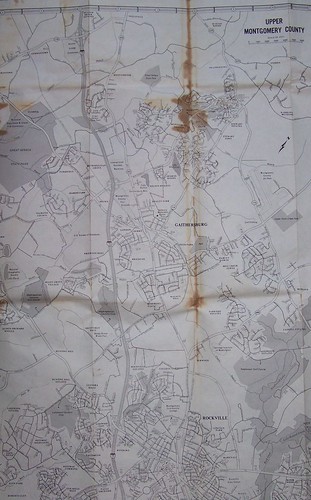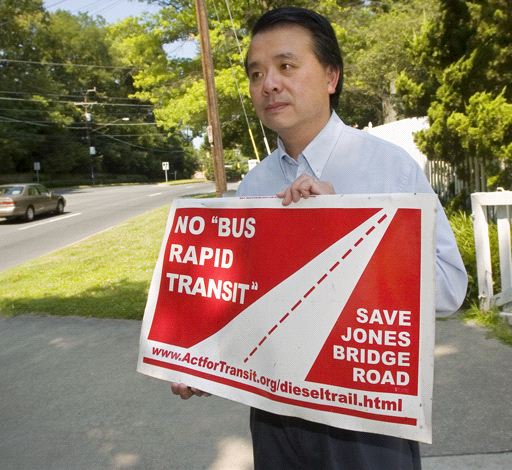Montgomery County, Maryland, freeway widening, and...

Montgomery County Maryland map, published by the American Automobile Association, 1973. Note that I-70 was later renamed as I-270. (Sorry about the stains, not sure if they are from the sun or from oil).
Cavan implores:
I know you're very District-focused but could you provide a link to David Alpert's letter form on GGW? It's a letter to the Montgomery County Council to oppose widening I270. I know that none of I270 passes through the District, but it would generate more auto traffic that would flood down through lower Montgomery and the District, generating demand for more parking and road widenings in our urban areas. It's Stupid Growth at its finest. It'll take up funds that would go towards heavy rail, light rail, bus, and boulevardization projects in Maryland (including inside the Beltway) for years. I'm sure many of your readers would live in Maryland and have a similar views. We need all we can get on this one.
Here is the link to more on the issue and the webform which you can use to weigh in on this issue, "On Tuesday, Montgomery Council can avoid "ICC 2.0".
2. The Washington Business Journal, in "Rollin Stanley talks Montgomery County Growth at DesignDC," reports on remarks made by the Planning Director for Montgomery County, and his presentation at DesignDC and better Growth policies for Montgomery County. From the article:
We've added 195,000 people since 1988 and they took up 40,000 acres of land. We don't have that for the next 195,000 people," Stanley said, adding that the only land the county has left is 8,000 acres of surface parking lots, 14,000 acres of non-continuous vacant land, and 10,500 acres of land around Metro stations. ...
"In Montgomery County, two factors influence development - schools and road capacity," Stanley said. "That pushes development to where there is no congestion, but it should go the other way, because congestion will force people onto public transportation."
Stanley also told the crowd that Montgomery County residents should be more open to buses as a form of transportation in new urban centers, since it is cheaper than heavy or light rail. "There is a stigmatism against buses-that they are for poor people or people who don't look like us. Buses are a good thing and take cars off the road," he said.
According to the planner, Montgomery County needs to eliminate its strip malls, use surface parking lots for high-rise developments and encourage residents to bike and walk to stores. Stanley added that eliminating cul-de-sacs and slowing down traffic on main streets are key to improving an area's walkability.
So it seems as if the I-270 widening is at odds with a new paradigm for compact development. Also see "Sea Change Recommended in Montgomery Growth Policy from the Washington Post.
3. Even so, road proponents might argue for freeway widening to help support bus rapid transit, as that mode of transit service has been endorsed for the the "Corridor Cities Transitway" between Frederick, Maryland and Montgomery County to connect to the Shady Grove red line subway station. See "Bus route, toll lanes backed for 270 corridor" from the Gazette.
4. And just to keep it interesting, our friends at Action Coalition for Transit, the pro-transit advocates in Montgomery County are continuing to call attention to pro-bus antics by the Town of Chevy Chase vis-a-vis the Purple Line. See "Chevy Chase neighbors clash over Purple Line plan," from the Gazette. And also this column by Robert McCartney in the Post, "Chop a Tree, Save the Environment."

Gazette photo.
5. That being said, I think that the big focus on bus rapid transit in the Washington region, as discussed in yesterday's Post, "A Fast Track to a Busway: Agency May Seek U.S. Funds for Network of Special Lanes," should be admitted as a satisficing move--that the money isn't there to build fixed rail transit.
In any case, this structure of bus routes was laid out in the 2003 WMATA Regional Bus Study.
Still, what happens when you build it and they don't come...? As is the case for most enhanced bus services in the U.S. Bus rapid transit does work in South America, see "By Degrees - Buses May Aid Climate Battle in Poor Cities" from the New York Times, but mostly because the rate of automobile ownership is far less than that in the U.S. (For another take, see this NYT Sunday Magazine article from 2007, "Recycle City: Road to Curitiba.")
In the U.S., the issue is getting people to shift their preference for driving to transit. And buses, for the most part, don't do that. People with choice prefer the predictability and comfort of fixed rail transit.
Labels: bus rapid transit, car culture and automobility, Growth Machine, neighborhood-based transportation planning, smart growth vs. smarter sprawl, transit and economic development, transit management



1 Comments:
Cleaning company Khamis Mushait
Every woman suffers from the daily cleaning of her home but she may not get the perfect cleanliness she wants. So a cleaning company in the mother of sahk offers my lady the perfect solution to clean your house or villa without bothering you and the desired cleaning. Efficiency, and through our company you can get the floors of a bright and neat house and clean water tanks and walls are very clean while preserving the colors, and also the marble شركة تنظيف بخميس مشيط
Post a Comment
<< Home